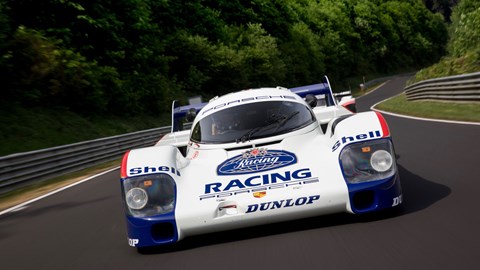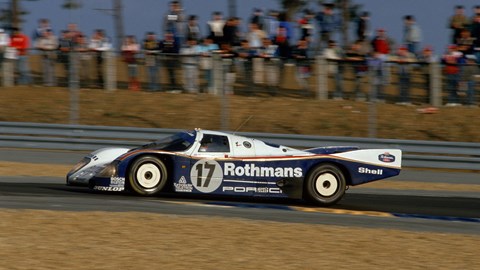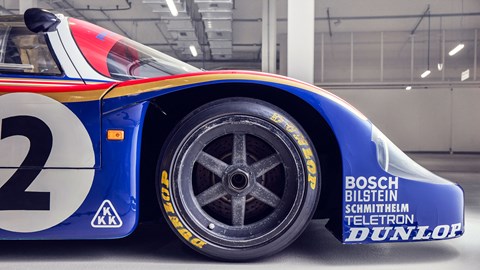► Porsche’s first ground-effect car
► From 956 to 962
► Multiple Le Mans winner
In 1982 new Group C rules ushered in restricted fuel usage but enticingly allowed for completely free engine development. Porsche’s reliable but stillborn IndyCar engine was its weapon of choice but everything else on its 956 race car was new. Porsche’s first monocoque chassis, built from riveted and bonded sheet aluminium, was 80 per cent stiffer than the 936’s tubular frame despite a longer wheelbase. The 956 was Porsche’s first ground-effect car too, with the engine tilted up at the rear to make space for the venturi tunnels.
Ground effect
‘We knew ground effect was in Formula 1 with Lotus and it looked easy’, says Norbert Singer, the engineer who played a part in every single Porsche victory at Le Mans between 1970 and 1998. ‘We quickly realised it wasn’t! And yet we never changed the monocoque. We found the aero balance within weeks, and it was just nine months between starting work on the car and its first race.’
You can now drive the 962 C in GT Sport
At the first test, the team thought driver Jürgen Barth had gone off the track as the venturis were covered in dust – it was just the ground effect literally hoovering up Porsche’s Weissach test circuit. The cornering speeds were of a different order of magnitude, and when Derek Bell drove it back-to-back with the Can-Am conquering 917/30 in June 1983, despite narrower tyres and giving away 300bhp, the 956 was four seconds quicker around the lap.

Success at Le Mans
At Le Mans in 1982 the 956 finished 1-2-3 – and it was 10 per cent more fuel efficient than the 936 that won the year before. A year later it was more dominant still, with Porsche filling nine of the top 10 places (which led to the infamous ‘Nobody’s Perfect’ poster).
The 1984 season was different, as Porsche refused to enter Le Mans – it had met new fuel regulations, which slowed the 956, but rivals hadn’t and were allowed to race without the handicap. It didn’t matter, as a customer 956 still won in the hands of Reinhold Joest (who would go on to oversee 14 more Le Mans victories for Porsche and then Audi) while seven other 956s finished in the top 10. And despite its absence from Le Mans, the works Rothmans-Porsche team would still win the drivers’ and manufacturers’ world titles that year – their third whitewash in a row.

Evolving to the 962
Joest won again in 1985, holding off the newer 962Cs, but the rest of the decade was theirs. An evolution of the 956 with the wheelbase extended 120mm to move the driver’s feet behind the front axle, the 962 was originally built to meet America’s IMSA regulations. It was soon adapted for Group C, then further developed with a bigger engine, larger wheels and tyres, and Porsche’s first attempt at a double-clutch PDK gearbox.
It won the world championship in 1985, did the same again in ’86 (to go with victory at Le Mans) and while the Silk Cut Jaguars won eight of the 10 rounds in 1987, one solitary car kept going for 24 hours to give Porsche its sixth 956/962 Le Mans victory (and seventh in a row).

Back once again
Just as the 917 didn’t die, neither did the 962. Despite being outlawed from racing, Porsche found a loophole in the rules and helped Jochen Dauer enter his insane street-legal 962 into the 1994 24 Hours of Le Mans. It was in the same class as Vipers and F40s, but beat Toyota for overall victory.
Even that wasn’t quite the end, because in crude terms the back half of the 962 was welded to the front of a 993-generation 911 and entered at Le Mans in ’96. It never won (a Porsche-engined TWR prototype run by a certain Mr Joest took the chequered flag that year, and again in ’97) but it was still victorious in the GT1 category, finishing second and third overall.